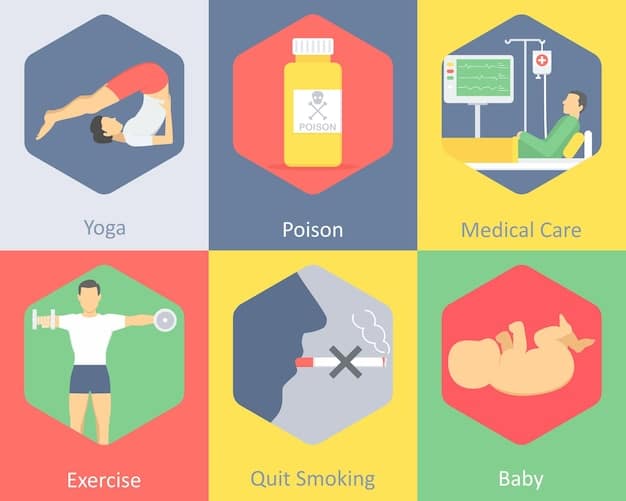The Ultimate Guide to Creatine: Boost Performance, Dosage & Safety

The Ultimate Guide to Creatine: Benefits, Dosage, and Side Effects explores how creatine, a popular supplement, can enhance muscle strength and power. This detailed guide covers the science behind creatine, optimal dosages, potential side effects, and safety considerations for maximizing its benefits.
Creatine is one of the most researched and popular supplements in the fitness world. If you’re looking to understand the ultimate guide to creatine: benefits, dosage, and side effects, you’ve come to the right place. This guide will delve into everything you need to know to make informed decisions about creatine supplementation.
Whether you’re an athlete, a bodybuilder, or simply someone looking to improve your physical performance, creatine can be a valuable tool. Let’s explore the science-backed benefits, proper dosages, and potential side effects to help you decide if creatine is right for you.
Understanding Creatine: What Is It?
Creatine is a naturally occurring compound found in muscle cells. It plays a crucial role in energy production during high-intensity exercises. Supplementing with creatine can increase its concentration in your muscles, leading to various performance enhancements.
How Creatine Works in the Body
Creatine primarily works by increasing the availability of ATP (adenosine triphosphate), the primary energy currency of cells. During intense activity, ATP is quickly depleted, and creatine helps regenerate it, allowing you to maintain higher levels of performance for longer periods.
Additionally, creatine can draw water into muscle cells, increasing cell volume. This not only contributes to muscle size but also triggers several anabolic processes that promote muscle growth and strength gains.
Sources of Creatine
Creatine can be obtained from dietary sources, mainly meat and fish. However, the amount of creatine you can get from food is relatively low. Supplementation allows you to saturate your muscles with creatine more efficiently.
- Meat: Red meat, such as beef and pork, is a good source of creatine.
- Fish: Certain types of fish, like tuna and salmon, contain creatine.
- Supplements: Creatine monohydrate is the most common and well-researched form of creatine supplement.
In summary, creatine is a naturally occurring substance that boosts ATP regeneration, enhancing muscle function and growth. Adequate dietary intake and supplementation ensure optimal creatine levels for improved performance.
The Benefits of Creatine Supplementation
Creatine supplementation offers a wide range of benefits, especially for athletes and those engaged in high-intensity training. From increasing muscle strength to improving cognitive function, the positive effects are well-documented.

Enhanced Muscle Strength and Power
One of the primary benefits of creatine is its ability to increase muscle strength and power output. This is particularly valuable for resistance training and high-intensity sports. Studies have shown that creatine supplementation can lead to significant improvements in bench press, squat, and other strength exercises.
Improved Athletic Performance
Creatine can significantly boost athletic performance by enhancing energy production and reducing fatigue. Athletes often experience improved sprint times, jumping ability, and overall endurance. This makes creatine a staple supplement for many competitive sports.
Increased Muscle Mass
Creatine promotes muscle growth by increasing cell hydration and stimulating protein synthesis. The increased water content in muscle cells creates a favorable environment for muscle growth, while the enhanced protein synthesis helps repair and build muscle tissue. Taking the ultimate guide to creatine: benefits, dosage, and side effects into consideration helps maximize these outcomes.
- Better Workout Performance: Creatine helps you push harder and longer during workouts.
- Faster Recovery: Creatine reduces muscle damage and inflammation, promoting faster recovery.
- Increased Muscle Fullness: Creatine increases water retention in muscle cells, making them look fuller and more defined.
Overall, the consistent use of creatine leads to notable gains in strength, power, and muscle mass, all contributing to improved athletic and physical performance.
Dosage Guidelines for Creatine
Proper dosage is essential to maximize the benefits of creatine while minimizing potential side effects. The most common approach involves a loading phase followed by a maintenance phase to maintain elevated creatine levels in your muscles.
Loading Phase
The loading phase typically involves taking 20 grams of creatine per day, divided into 4 doses of 5 grams each, for 5-7 days. This quickly saturates your muscles with creatine, leading to rapid improvements in strength and performance.
Maintenance Phase
After the loading phase, you transition to a maintenance phase, where you take 3-5 grams of creatine per day. This dosage is sufficient to maintain the elevated creatine levels in your muscles. Some people choose to skip the loading phase and start directly with the maintenance dose, though the effects will be slower to appear.
Creatine Cycling: Is It necessary?
Some people advocate for cycling creatine, taking it for a certain period followed by a break. However, there is no strong evidence to support the necessity of creatine cycling. Continuous use of creatine has been shown to be safe and effective for long-term benefits.
- Loading Phase Dosage: 20 grams per day for 5-7 days.
- Maintenance Phase Dosage: 3-5 grams per day.
- Timing: Creatine can be taken at any time of the day, but many prefer post-workout.
Following these dosage guidelines ensures optimal creatine levels in your muscles, maximizing its benefits for strength, power, and muscle growth.
Potential Side Effects and Safety Considerations
While creatine is generally considered safe, some potential side effects and safety considerations should be taken into account. Understanding these aspects can help you use creatine responsibly and avoid any adverse effects.

Common Side Effects
The most commonly reported side effect of creatine is water retention, which can lead to a temporary increase in body weight. Other potential side effects include stomach discomfort, bloating, and muscle cramps. These effects are usually mild and can be mitigated by staying hydrated and following recommended dosages.
Dehydration
Creatine draws water into muscle cells, which can potentially lead to dehydration if you don’t drink enough water. To avoid dehydration, it’s important to increase your water intake when supplementing with creatine. Aim for at least 8-10 glasses of water per day.
Kidney Health
There has been some concern about creatine’s effect on kidney health. However, studies have shown that creatine is safe for individuals with healthy kidneys. If you have pre-existing kidney conditions, it’s best to consult with a healthcare professional before using creatine. Understanding the ultimate guide to creatine: benefits, dosage, and side effects helps reduce this risk.
- Stay Hydrated: Drink plenty of water.
- Follow Dosage Guidelines: Stick to recommended dosages.
- Consult a Doctor: If you have pre-existing health conditions, consult your doctor.
In summary, while creatine is generally safe, being aware of potential side effects and taking preventive measures ensures a safe and effective supplementation experience.
Types of Creatine Supplements
Creatine is available in various forms, each with its own advantages and disadvantages. Understanding the different types can help you choose the best option for your needs and preferences.
Creatine Monohydrate
Creatine monohydrate is the most common and well-researched form of creatine. It is highly effective, affordable, and widely available. Many studies have demonstrated its safety and efficacy, making it a reliable choice for most users. It’s a cornerstone of the ultimate guide to creatine: benefits, dosage, and side effects.
Creatine Ethyl Ester (CEE)
Creatine ethyl ester (CEE) is another form of creatine that is marketed for its supposedly better absorption. However, studies have shown that CEE is not as effective as creatine monohydrate and may even degrade into inactive products in the body.
Creatine Hydrochloride (HCl)
Creatine hydrochloride (HCl) is touted for its superior solubility and reduced water retention. Some users find it easier to digest than creatine monohydrate. However, more research is needed to confirm its efficacy compared to creatine monohydrate.
- Creatine Monohydrate: Most researched and cost-effective.
- Creatine Ethyl Ester (CEE): Not as effective as monohydrate.
- Creatine Hydrochloride (HCl): Easier to digest for some users.
In brief, while there are several forms of creatine available, creatine monohydrate remains the gold standard due to its proven effectiveness and safety.
Integrating Creatine into Your Fitness Routine
To maximize the benefits of creatine, it’s important to integrate it effectively into your overall fitness and nutrition plan. Combining creatine with a balanced diet and consistent training regimen can yield impressive results.
Timing of Creatine Intake
The timing of creatine intake can influence its effectiveness. While creatine can be taken at any time of the day, many people prefer taking it shortly before or after their workouts. Post-workout consumption may enhance muscle uptake due to increased blood flow and insulin sensitivity.
Combining Creatine with Other Supplements
Creatine can be safely combined with other supplements to enhance overall performance. For example, combining creatine with protein supplements can further stimulate muscle growth and recovery. Beta-alanine is another supplement that synergizes well with creatine for improved endurance.
Dietary Considerations
A balanced diet rich in protein and carbohydrates is essential to support the benefits of creatine. Adequate protein intake is necessary for muscle repair and growth, while carbohydrates help replenish glycogen stores and provide energy for workouts. Following the ultimate guide to creatine: benefits, dosage, and side effects ensures that dietary habits align with supplementation goals.
- Timing: Consider taking creatine pre- or post-workout.
- Combinations: Combine with protein and beta-alanine for enhanced results.
- Diet: Maintain a balanced diet with adequate protein and carbohydrates.
Consequently, a strategic approach combining the right timing, complementary supplements, and a supportive diet maximizes the effectiveness of creatine in your fitness journey.
| Key Point | Brief Description |
|---|---|
| 💪 Benefits | Increases strength, power, and muscle mass. |
| 🧪 Dosage | Loading phase: 20g/day for 5-7 days; Maintenance: 3-5g/day. |
| 💧 Hydration | Drink 8-10 glasses of water daily to avoid dehydration. |
| ✅ Safety | Generally safe; consult a doctor with pre-existing kidney issues. |
Frequently Asked Questions (FAQ)
Creatine is a natural compound that helps regenerate ATP, the primary energy source for muscle contractions. It increases muscle strength, power, and size.
Creatine monohydrate is the most researched and effective form of creatine. It is affordable, widely available, and has proven benefits for performance.
Some people may experience water retention, bloating, or stomach discomfort. Staying hydrated and following recommended dosages can minimize these effects. This is considered in the ultimate guide to creatine: benefits, dosage, and side effects.
Creatine is most effective for high-intensity, short-duration activities like weightlifting and sprinting. It may not be as beneficial for endurance exercises.
Studies have shown that creatine is safe for long-term use in healthy individuals. However, it’s always best to consult with a healthcare professional before starting any new supplement regimen.
Conclusion
In conclusion, the ultimate guide to creatine: benefits, dosage, and side effects reveals that creatine is a potent supplement for enhancing muscle strength, power, and growth. Proper dosage, hydration, and awareness of potential side effects are key to maximizing its benefits and ensuring its safe use.





